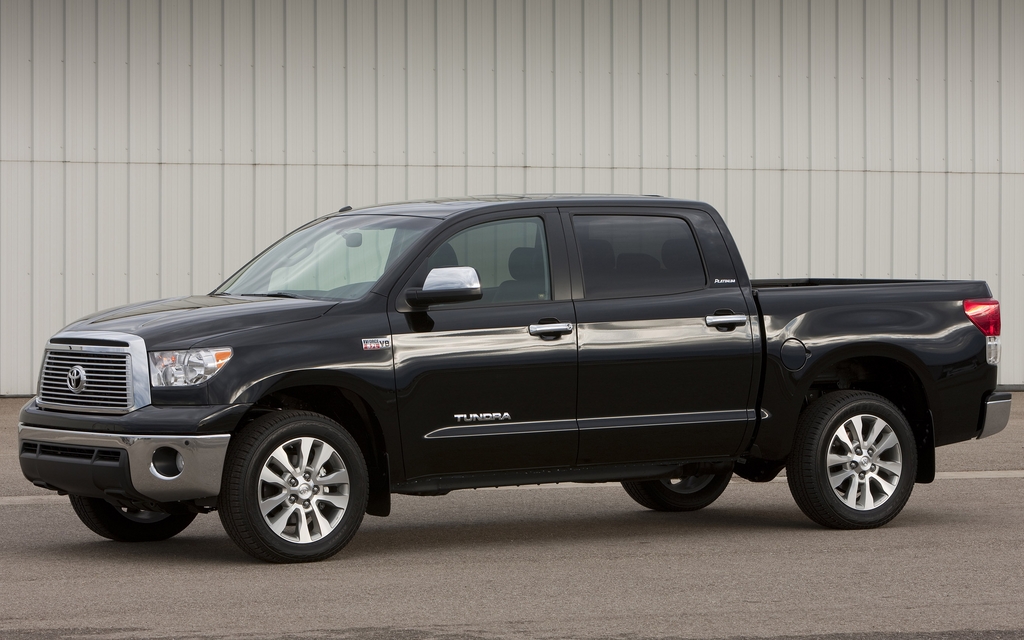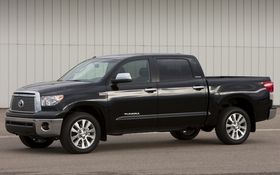The 2012 Toyota Tundra: Is it stuck in the ice age?

| Strong points |
|
|---|---|
| Weak points |
|
Few manufacturers have had a tougher time of it than Toyota, at least as of late. Sure, Hyundai and Kia might be skyrocketing to sales success in a stupendous manner, but then again, they were never subjected to the same stringent expectations as Toyota. And whilst Ford has managed to carry a ridiculous amount of momentum through the recession on the strength of their products, the Blue Oval never went three rounds with an earthquake, tsunami, and nuclear disaster. Add to this the fact that the beleaguered archetypal Japanese brand has slightly more than zero corporate full-size truck culture, and the mere existence of the Tundra starts to look like a bit of a miracle.
But, if I’m honest, it will be its continued existence that proves to be the greatest miracle. I first tested the new Tundras back when Toyota, as well as seemingly every media outlet, were citing it as the death knell for the American pickup truck. Now, I’m a naturally critical person, and any claim even half as grandiose as that would have at least one eyebrow headed for my hairline. After all, here was an end-zone run on the proper full-size truck market that incorporated a new production facility, a new powertrain, and a new pickup truck… all of which remained largely untested, and all of which was overseen by a company best known for its line of small and reliable compact sedans.
Fast forward a few years, and not much has changed with the Tundra. Granted, a few kinks in the supply, production, and vehicle design have been worked out since the truck’s 2007 debut, but it remains largely unchanged. The same high-revving 5.7 litre V8 that made waves during the truck’s debut can still be found in the uppermost reaches of the Tundra lineup, while the old 4.7 litre was tossed in 2010 in favour of the new 4.6L V8 sourced from the Lexus LS460 of all places, albeit sans that car’s direct fuel injection. An improvement over the decades-old 4.7L, the new engine produces 310 horsepower 327 foot pounds of torque, but retains a distinctly car-like personality in its preference for the latter half of the tachometer’s sweep. Similarly, slight updates made to the truck’s exterior styling have kept the designers busy, but haven’t really made the 2012 model all that recognizable over the original 2007.
Inside, it’s a similar story: much of the same. The dashboard is still visually dominated by the big silver swath of plastic that envelops the driver’s controls and instrument cluster, and it’s still absolutely festooned with a smuggler’s wet dream’s-worth of storage nooks, crannies, and bins. Between the massive centre console, its multi-function lid, the lord-knows-how-many cupholders, and the various other receptacles you’ll find located with the dashboard, door panels, and seats, the presence of the gigantic rear bed seems almost superfluous… there’s just that much interior cargo space. And the layout is pretty good too. Giant controls for everything from the HVAC to the stereo to the on-board fuel economy computer make it easy to work the Tundra’s various features with thickly gloved hands, and the simple nature of its layout pretty much negates any sort of learning curve that could be associated with learning its various features.
But, whilst all those features were pretty nice back in 2007, they’re starting to get a little dated now. The giant buttons and knobs that made sense back then still make the same sense, but the piano black trim they’re mounted on top of doesn’t: if you’re wearing thick gloves, there’s a pretty good chance they’ll scratch the crap out of that shiny black plastic around those big HVAC knobs. And if you get one that is less than fully loaded, you’ll also have to put up with a plethora of overly obvious blacked-out switch block-off plates appearing throughout your truck’s interior; something the competition has been working hard to avoid.
And then there’s the ride. Initially lauded for its pleasingly car-like ride and handling, the Tundra’s gotten no worse with the passage of time, but has been surpassed by at least a couple of its biggest competitors. Powered by engines that thrive on high revs, they scream through passing manoeuvres and merge lanes, but consistently feel as if they need to be beaten senseless by a couple gear ratios before all their horsepower opt to participate. When they were new, they may have wowed with their impressive (and then unsurpassed top-end thrust), but today the 4.6L feels unwilling throughout most of the pedal’s travel, and overly urgent when firmly prodded.
Same goes for the suspension. Although it’s still ridiculous soft and supple, there have been some huge strides made by both Ford and Dodge in this particular department, specifically with Dodge’s impressive new coil-spring rear suspension. And out on the highway, the Tundra's soft rebound damping and springs simply don't inspire confidence. But, its competition’s newfound prowess notwithstanding, the Tundra still manages to do a great job of isolating its occupants from the bumps and jostles of daily commuting, and still boasts one hell of an impressive turning circle.
But at this point, the last thing the Tundra needs to do is turn around. If they were ever well on their way to producing a viably competitive product that really could take the fight to Ford, Chevy, and Dodge’s footsteps, Toyota’s neglected the Tundra for years and, leaving it to languish nearly unarmed in one of the most hotly contested segments extant. And as much as I wish I could pull for the underdog and declare it another great option in the full-size truck market, I simply can’t. Compared to its competition, it is not luxurious enough, smooth enough, powerful enough, efficient enough nor cheap enough. But it’s not the Tundra’s fault. Beset upon by some very serious setbacks, Toyota has slightly bigger fish to fry before they can justify allocating any serious funding towards the Tundra’s further development. Add to that the recent booster shot that Dodge and Chevy were awarded by the American and Canadian governments in the form of bailout funds, and it rapidly starts to look like the deck has been stacked against the Tundra’s favour. But, this isn’t the first time Toyota has faced these sorts of adversities, and it certainly won’t be the last… and if history can teach us anything about how that particular company handles adversity, one would be wise to consider the Tundra’s position as perhaps down, but certainly not out.









